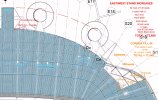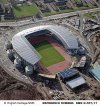It wasn't for wind it was for natural sunlight which improves the quality of the playing surface.
Here’s an extract from the CoMS Design Study that explains the reason for the vents
Pitch ventilation
An inherent problem in designing large stadia is to create
a roof that not only shelters (with ‘drip-line’ cover to all
spectators) but also ventilates the pitch. Daylight, sunlight,
and air movement over the pitch are essential for healthy
grass growth but a wind-free and comfortable arena is
also needed.
The dramatic roof form and corresponding stand
configuration allowed movable louvre vents in the high-level
corner voids. These vents can be adjusted to increase or
decrease airflow through the Stadium, and thus benefit
not only air movement over the pitch but also the spectator
environment. Similar low-level vents are also incorporated in
the corner exit gates.
Under most circumstances these precautions would have
been adequate to ensure good grass growth, but Arup
wanted to ensure the very best pitch possible. A further
ventilation system was therefore added, this time beneath
the pitch as for golf courses. At close centres perforated
pipes were laid; these double for pitch drainage and through
them air can be either pumped or sucked. Humidity detectors
in the root zone of the turf show the groundsmen when the
pitch is too humid and needs drying out, or is too dry and
requires watering. Another benefit of the system is that
air can be pumped direct to the base of the turf, thereby
oxygenating the root zone and increasing turf growth.





